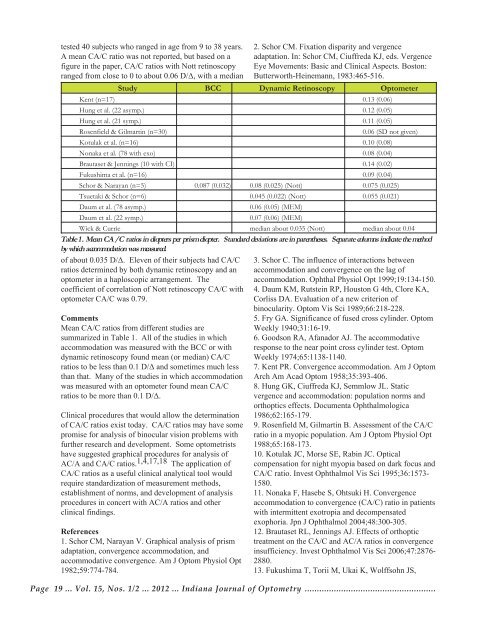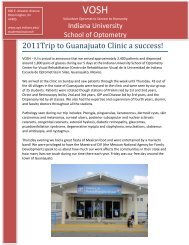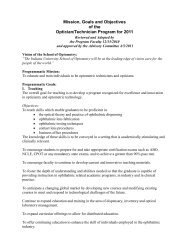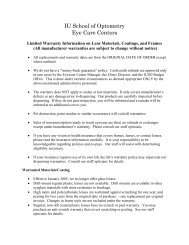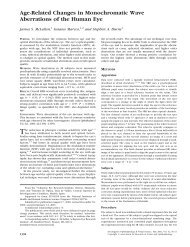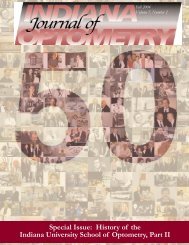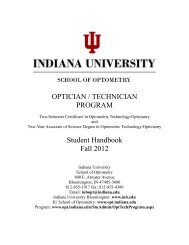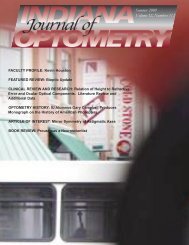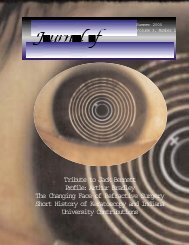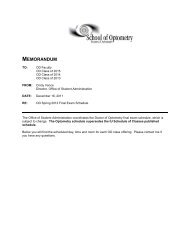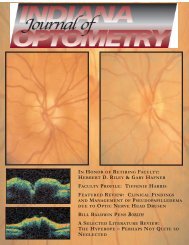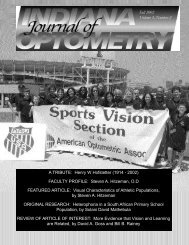Fall 2012 - Indiana University School of Optometry
Fall 2012 - Indiana University School of Optometry
Fall 2012 - Indiana University School of Optometry
You also want an ePaper? Increase the reach of your titles
YUMPU automatically turns print PDFs into web optimized ePapers that Google loves.
tested 40 subjects who ranged in age from 9 to 38 years.<br />
A mean CA/C ratio was not reported, but based on a<br />
figure in the paper, CA/C ratios with Nott retinoscopy<br />
ranged from close to 0 to about 0.06 D/Δ, with a median<br />
<strong>of</strong> about 0.035 D/Δ. Eleven <strong>of</strong> their subjects had CA/C<br />
ratios determined by both dynamic retinoscopy and an<br />
optometer in a haploscopic arrangement. The<br />
coefficient <strong>of</strong> correlation <strong>of</strong> Nott retinoscopy CA/C with<br />
optometer CA/C was 0.79.<br />
Comments<br />
Mean CA/C ratios from different studies are<br />
summarized in Table 1. All <strong>of</strong> the studies in which<br />
accommodation was measured with the BCC or with<br />
dynamic retinoscopy found mean (or median) CA/C<br />
ratios to be less than 0.1 D/Δ and sometimes much less<br />
than that. Many <strong>of</strong> the studies in which accommodation<br />
was measured with an optometer found mean CA/C<br />
ratios to be more than 0.1 D/Δ.<br />
Clinical procedures that would allow the determination<br />
<strong>of</strong> CA/C ratios exist today. CA/C ratios may have some<br />
promise for analysis <strong>of</strong> binocular vision problems with<br />
further research and development. Some optometrists<br />
have suggested graphical procedures for analysis <strong>of</strong><br />
AC/A and CA/C ratios. 1,4,17,18 The application <strong>of</strong><br />
CA/C ratios as a useful clinical analytical tool would<br />
require standardization <strong>of</strong> measurement methods,<br />
establishment <strong>of</strong> norms, and development <strong>of</strong> analysis<br />
procedures in concert with AC/A ratios and other<br />
clinical findings.<br />
References<br />
1. Schor CM, Narayan V. Graphical analysis <strong>of</strong> prism<br />
adaptation, convergence accommodation, and<br />
accommodative convergence. Am J Optom Physiol Opt<br />
1982;59:774-784.<br />
2. Schor CM. Fixation disparity and vergence<br />
adaptation. In: Schor CM, Ciuffreda KJ, eds. Vergence<br />
Eye Movements: Basic and Clinical Aspects. Boston:<br />
Butterworth-Heinemann, 1983:465-516.<br />
Study BCC Dynamic Retinoscopy Optometer<br />
Kent (n=17) 0.13 (0.06)<br />
Hung et al. (22 asymp.) 0.12 (0.05)<br />
Hung et al. (21 symp.) 0.11 (0.05)<br />
Rosenfield & Gilmartin (n=30)<br />
0.06 (SD not given)<br />
Kotulak et al. (n=16) 0.10 (0.08)<br />
Nonaka et al. (78 with exo) 0.08 (0.04)<br />
Brautaset & Jennings (10 with CI) 0.14 (0.02)<br />
Fukushima et al. (n=16) 0.09 (0.04)<br />
Schor & Narayan (n=5) 0.087 (0.032) 0.08 (0.025) (Nott) 0.075 (0.025)<br />
Tsuetaki & Schor (n=6) 0.045 (0.022) (Nott) 0.055 (0.021)<br />
Daum et al. (78 asymp.)<br />
0.06 (0.05) (MEM)<br />
Daum et al. (22 symp.)<br />
0.07 (0.06) (MEM)<br />
Wick & Currie median about 0.035 (Nott) median about 0.04<br />
Table 1 . Mean CA /C ratios in diopters per prism diopter. Standard deviations are in parentheses. Separate columns indicate the method<br />
by which accommodation was measured.<br />
3. Schor C. The influence <strong>of</strong> interactions between<br />
accommodation and convergence on the lag <strong>of</strong><br />
accommodation. Ophthal Physiol Opt 1999;19:134-150.<br />
4. Daum KM, Rutstein RP, Houston G 4th, Clore KA,<br />
Corliss DA. Evaluation <strong>of</strong> a new criterion <strong>of</strong><br />
binocularity. Optom Vis Sci 1989;66:218-228.<br />
5. Fry GA. Significance <strong>of</strong> fused cross cylinder. Optom<br />
Weekly 1940;31:16-19.<br />
6. Goodson RA, Afanador AJ. The accommodative<br />
response to the near point cross cylinder test. Optom<br />
Weekly 1974;65:1138-1140.<br />
7. Kent PR. Convergence accommodation. Am J Optom<br />
Arch Am Acad Optom 1958;35:393-406.<br />
8. Hung GK, Ciuffreda KJ, Semmlow JL. Static<br />
vergence and accommodation: population norms and<br />
orthoptics effects. Documenta Ophthalmologica<br />
1986;62:165-179.<br />
9. Rosenfield M, Gilmartin B. Assessment <strong>of</strong> the CA/C<br />
ratio in a myopic population. Am J Optom Physiol Opt<br />
1988;65:168-173.<br />
10. Kotulak JC, Morse SE, Rabin JC. Optical<br />
compensation for night myopia based on dark focus and<br />
CA/C ratio. Invest Ophthalmol Vis Sci 1995;36:1573-<br />
1580.<br />
11. Nonaka F, Hasebe S, Ohtsuki H. Convergence<br />
accommodation to convergence (CA/C) ratio in patients<br />
with intermittent exotropia and decompensated<br />
exophoria. Jpn J Ophthalmol 2004;48:300-305.<br />
12. Brautaset RL, Jennings AJ. Effects <strong>of</strong> orthoptic<br />
treatment on the CA/C and AC/A ratios in convergence<br />
insufficiency. Invest Ophthalmol Vis Sci 2006;47:2876-<br />
2880.<br />
13. Fukushima T, Torii M, Ukai K, Wolffsohn JS,<br />
Page 19 ... Vol. 15, Nos. 1/2 ... <strong>2012</strong> ... <strong>Indiana</strong> Journal <strong>of</strong> <strong>Optometry</strong> ......................................................


